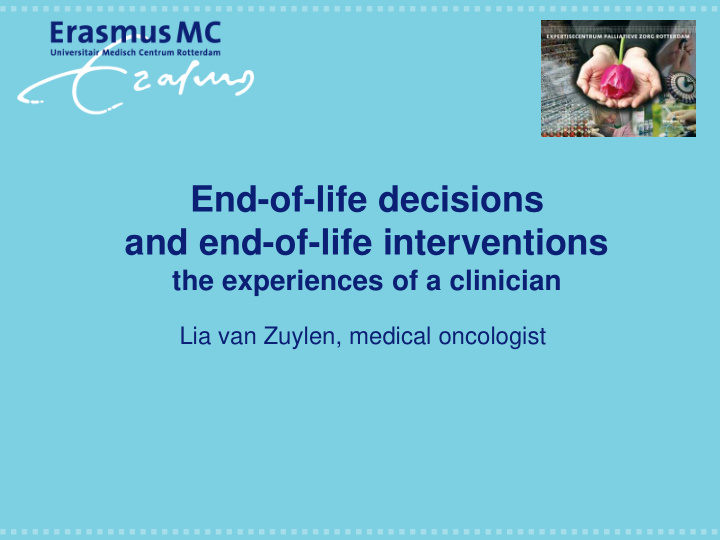



End-of-life decisions and end-of-life interventions the experiences of a clinician Lia van Zuylen, medical oncologist
Content Palliative sedation The Dutch guideline Euthanasia The Dutch law Never too early to speak about euthanasia The effect on the doctor-patient relation The practice
Ms S, 58 years 2004 primary breast cancer, ER+ 2008 bone, lung and cutaneous metastases 2008 - 2018 several lines of hormone and chemotherapy 2018 rapid progression of dyspnoea, suffered for a longer time of necrotic cutaneus metastases (cancer-en-cuirasse) No systemic treatment options No effect on morfine Life expectancy of a few days Start of palliative sedation after arrival of her daughter from abroad Died12 hours after the start of sedation
What is palliative sedation (PS)? (Dutch national guideline) Definition: deliberate lowering of a patient's level of consciousness in the last stages of life Object: relieve suffering NOT to lengthen or shorten the patient’s life Two different situations: 1. continuous sedation until the moment of death 2. brief or intermittent sedation 4
Which patient receives PS? Patient suffering of refractory symptoms = none of the conventional modes of treatment is effective or fast-acting enough, and/or if these modes of treatment are accompanied by unacceptable side-effects with a life expectancy of less than 2 weeks who agreed with this treatment 5
How is the patient sedated? By a sedative, most often a benzodiazepine (midazolam) administered proportionately = not the degree to which consciousness is lowered, but the degree of symptom control that should determine the dose, combinations, and duration of the drugs administered to achieve palliative sedation Increase of morphine is not the drug of choice: - sedative effect is unsure - may increase/induce a delirium Morphine should only be given or continued (alongside sedatives) to relieve pain and/or dyspnoea 6
Euthanasia
Ms S, 58 years Known for 10 years with metastatic breast cancer 6 years ago she talked with her GP and her medical specialist about the option of euthanasia for the future both doctors explained their possibilities and position at several times patient and her doctors discussed the subject again for a long time there was no actual wish 3 months ago the cutaneous metastases were progressive No further treatment options, more suffering and difficult to care for 2 weeks ago patient discussed an actual wish for euthanasia with her GP
The Dutch law Still a punishable offence under the Dutch Penal Code Only permissible if the relevant due care criteria are met: a voluntary and well-considered request from the patient unbearable suffering without any prospect of improvement patient is well informed about the situation and (treatment) options lack of a reasonable alternative consultation of at least one independent physician who sees the patient and gives a written opinion regarding the due care criteria performance of the act with due medical care After the act: report to one of five regional review committees on euthanasia to assess whether the physician has fulfilled the due care criteria
Euthanasia is a process not a moment Always schedule a meeting with the patient as he/she mentions the possibility of euthanasia (in the future) Be open about your own position, possibilities and boundaries Explore expectations and identify limitations Explain that euthanasia is part of the care around dying Be always in charge of the process
The efffect on the patient-doctor relation Ms H, 53 years, known with metastatic lung cancer a husband and 2 sons, always busy for other people I met her once at the out-patient clinic Soon the medical situation detoriated and she asked for euthanasia because of the deteriation, her inactivity due to fatigue and her fear for more suffering in the near future Life expectancy of several weeks – month(s) I understood her wish the moment she saw me as another human being with her own considerations we were in line with each other
Change in relationship Kimsma et al; MC 2008 Doctor: chance of loosing professional distance and objectivity feels the burden of an ethical difficult process Patient: knows that wish for euthanasia is confronting feels the act is on the border of what people may ask from each other waits until doctor has clear view on the situation Change in relation shows characteristics of friendship: share of an intimate period of life behaviour on the boundary of what is possible between human beings respect on both sides is essential
However the process of euthanasia always has to be within professional borders and Euthanasia should never become a ‘normal’ procedure for a doctor
The practice Erasmus MC Leidraad: acting in case of actual wish for euthanasia Inform other caregivers of the patient Inform the patient when your decison will be made In case of not approving the wish: motivate and discuss other options In case of approving the wish: discuss with patient and relatives what has to be done and will happen have several conversations with them consult the independent physician write the report of the whole process inform the coroner
The day of the euthanasia No cell phone, no appointments around the procedure Be in contact with the patient, the relatives and the nurse Check the medical supplies The procedure midazolam push – induce sleep thiopental by syringe driver – induce deep coma pancuronium (muscle relaxant) – induce cardial arrest Whole procedure takes 2-3 hrs time between start injections and death 10-15 min
Conclusion Palliative sedation and euthanasia are different interventions at the end of life Palliative sedation normal medical treatment to relieve suffering without the intention of shortening life doctor is the ‘owner’ Euthanasia never may become a normal medical intervention patient is the ‘owner’ doctor needs to have the control over the process 16
Recommend
More recommend